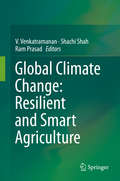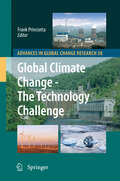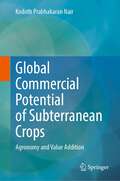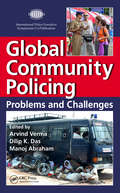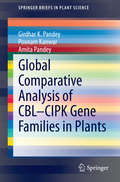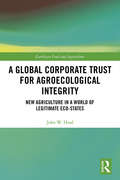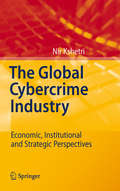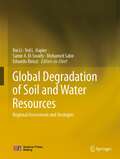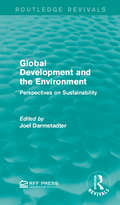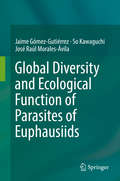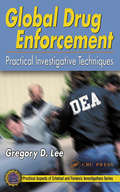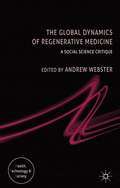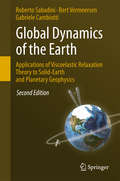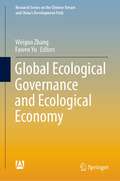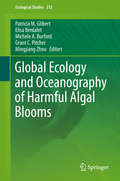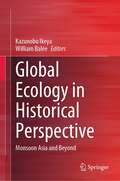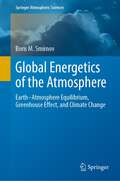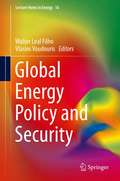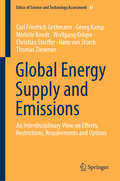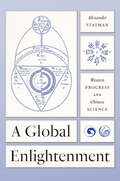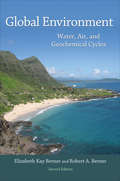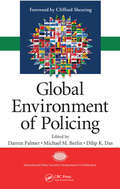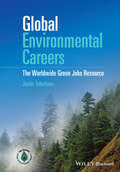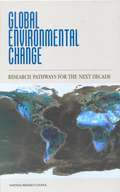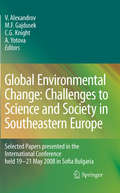- Table View
- List View
Global Climate Change: Resilient and Smart Agriculture
by V. Venkatramanan Shachi Shah Ram PrasadThis book provides essential insights into methods and practices of ‘Climate-smart Agriculture,’ which is driven by the principles of climate resilience and smart resource use in agricultural production. Climate-smart agriculture is a key policy instrument for achieving poverty eradication and a hunger-free world, as well as mitigating the effects of climate change. This book discusses in detail climate-smart agricultural technologies and practices that can reduce the vulnerability of agricultural systems, improve the livelihoods of farmers and other stakeholders, and reduce the greenhouse gas emissions from crop production and livestock husbandry. The agriculture, forestry and other land use (AFOLU) sector produces roughly 10–12 gigatons of CO2-equivalent per year; therefore, sustainable practices for agriculture and related land use hold immense potential to mitigate climate change. The potential impacts of climate variability and climate change on agriculture are extensively documented and articulated, especially with regard to global and national environmental agendas that call for innovation, transformation and climate-resilient advances in agriculture. As the book demonstrates, climate-smart agriculture offers an excellent tool for boosting agricultural output to feed the growing global population; for reducing greenhouse gases emissions from agriculture and other land use; and for protecting agricultural production systems from the impending dangers of climate change.
Global Climate Change - The Technology Challenge
by Frank PrinciottaIn order to avoid the potentially catastrophic impacts of global warming, the current 3% CO2 global emission growth rate must be transformed to a 1 to 3% declining rate, as soon as possible. This will require a rapid and radical transformation of the world's energy production and end use systems. The current generation of energy technologies are not capable of achieving the level of mitigation required. Next generations of renewable, low carbon generation and end use technologies will be needed. This book quantifies the mitigation challenge. It then considers the status of key technologies needed to protect the planet from serious climate change impact. Current and emerging technologies are characterized for their mitigation potential, status of development and potential environmental impacts. Power generation, mobile sources, industrial and building sectors are evaluated in detail. The importance and unique challenges for rapidly developing countries, such as China and India are discussed. Current global research and development efforts for key technologies are discussed. It is concluded that it will be necessary to substantially upgrade and accelerate the current worldwide RDD&D effort on both emerging energy technologies and those enabling technologies needed to improve mitigation effectiveness and economics. It will also be necessary to carefully evaluate the potential environmental characteristics of next generation technologies to avoid unacceptable health and ecological impacts. Finally, given the monumental technological challenge associated with transforming the world's energy system, geoengineering options are evaluated, since if successfully deployed, they have the potential to allow more time for the necessary energy system transformation. 'This book on Climate Change not only gives a clear picture of the problem but suggests many of the pitfalls in solving it and recommends strongly, a research program to fill the gaps in our knowledge. It is a most useful reference book for all aspects of the problem.' William D. Ruckelshaus, Madrona Venture Group/Evergreen Venture
Global Commercial Potential of Subterranean Crops: Agronomy and Value Addition
by Kodoth Prabhakaran NairTropical root and tuber crops form an important group of food crops for millions of people (about one-fifth of the world population), especially those living in the tropical and sub-tropical zones. Tuber crops are the third important food crops after cereals and grain legumes. The carbohydrates synthesized in the leaves and stored in the form of starch in the underground roots and tubers, which are not only for food, but also a raw material for several industries. Among the many tuber crops available, only a few have been domesticated and widely cultivated for edible and industrial purposes. This book addresses the principal issues connected with selected tuber and root crops, their origin, global distribution, cultivation details, and their global commercial potential, vis-à-vis the end products made out of them (value addition). Among the crops, sweet potato, cassava, yams, colocasia, west Indian arrowroot, asparagus, safed musli, Indian Bread root and gloria superba will be discussed.From various projections, it is evident that by the year 2050 the world population will face a serious food shortage, if current trends in cereals consumption is taken intoaccount. That is why root and tuber crops assume great importance. Contrary to the high-fertility soils, which are a requirement for principal cereals like rice and wheat, root and tuber crops can grow quite well in poor soils, under varying climatic conditions.
Global Community Policing: Problems and Challenges
by Arvind Verma, Dilip K. Das and Manoj AbrahamIn nations all over the world, community policing has been found extremely beneficial in improving public confidence in the police. Community-oriented policing and police-citizen cooperation is now the accepted framework for all progressive police departments. Drawn from the proceedings at the 2010 International Police Executive Symposium (IPES) in
Global Comparative Analysis of CBL-CIPK Gene Families in Plants
by Girdhar K. Pandey Poonam Kanwar Amita PandeyCalcium plays pivotal role in regulating the physiological as well as developmental processes in plants. Till now, several calcium sensors have been discovered, which regulate the diverse signaling pathways involved in plant growth and development. One of the major calcium sensors CBL (calcineurin B-like) is decoding the calcium signal during various environmental stresses in plants. Calcium mediated signal is transduced downstream by CBL-interacting protein kinases (CIPKs), which generally phosphorylate the target proteins such as transcription factors or transporters/channel leading to a response. Mutant based approach has provided valuable information in the functional analysis of individual members of CBL and CIPK gene family in Arabidopsis. Both CBL and CIPK gene families have previously been identified and characterized in Arabidopsis and rice. Identification and characterization of CBLs and CIPKs in other plant species such as Oryza sativa, Pisum sativum, Cicer arietinum, Zea mays, Populus euphratica, Vitis vinifera, Malus domestica, Gossypium hirsutum, Sorghum bicolor, Brassica napus, Vicia faba, Phaseolus vulgaris, Ammopiptanthus mongolicus and Triticum aestivum are still in juvenile stage. Overall, Global Comparative Analysis of CBL-CIPK Gene Families in Plants is a comprehensive study focused on the diverse role of CBL-CIPK module in different stress signaling and also to identify a newly emerging role of this calcium-signaling module in plant growth and development across different plant species. In addition, beside Arabidopsis, it will provide backbone of knowledge to perform a detail molecular investigation in crop plant species and could possibly enable in designing strategies to tame abiotic stress tolerance and development in important agronomical crop plants. This book will act as handy and informative source in this field for students as well as advanced researchers.
A Global Corporate Trust for Agroecological Integrity: New Agriculture in a World of Legitimate Eco-states (Earthscan Food and Agriculture)
by John W. HeadThis book examines global environmental governance and how legal, institutional, and conceptual reform can facilitate a transformation to a new ‘natural-systems’ form of agriculture. Profound global climate disruption makes it essential that we replace our current agricultural system – described in this book as a fossil-carbon-dependent ‘modern extractive agriculture’ – with a natural-systems agriculture featuring perennial grains growing in polycultures, thereby mimicking the natural grassland and forest ecosystems that modern extractive agriculture has largely destroyed. After examining relevant international legal and conceptual foundations (sovereignty, federalism, global governance) and existing international organizations focusing on agriculture, the book explores legal and institutional opportunities to facilitate dramatic agricultural reform and ecological restoration. Among other things, it explains how innovative federalism structures around the world provide patterns for reorienting global environmental governance, including what the book calls eco-states that would, through exercise of pluralistic sovereignty, be responsible for agroecological management. Drawing from his experience working in international institutions, the author provides detailed global-governance proposals for facilitating the type of agricultural reform that can help avoid ecological collapse, especially through soil degradation and climate change. This book will be of great interest to students and scholars of international law, agroecology, climate change, ecological restoration, sustainable development, and global governance, as well as policy-makers and practitioners working in these fields.
The Global Cybercrime Industry
by Nir KshetriThis book is about the global cybercrime industry, which according to some estimates, is a US$1 trillion industry and is growing rapidly. It examines economic and institutional processes in the cybercrime industry, provides insights into the entrepreneurial aspect of firms engaged in cyber-criminal activities, takes a close look at cybercrime business models, explains the global variation in the pattern of cybercrimes and seeks to understand threats and countermeasures taken by key actors in this industry. This book's distinguishing features include the newness, importance, controversiality and complexity of the topic; cross-disciplinary focus, orientation and scope; theory-based but practical and accessible to the wider audience; and illustration of various qualitative and quantitative aspects of the global cybercrime industry.
Global Degradation of Soil and Water Resources: Regional Assessment and Strategies
by Rui Li Ted L. Napier Samir A. El-Swaify Mohamed Sabir Eduardo RienziThis book focuses on soil and water conservation at global scale. It is a serious environmental problem that will threaten the socio-economic well-being of the majority of global population in future. The book examines the current situation of land degradation in multiple regions of the world and offers alternative approaches to solve the problems through sharing advanced technologies and lessons learned. It provides comprehensive assessment on characteristics, level and effect of degradation in different regions. It’s a highly informative reference both for researchers and graduate students.
Global Development and the Environment: Perspectives on Sustainability (Routledge Revivals)
by Joel DarmstadterIn preparation for the United Nation’s Conference on Environment and Development in Rio de Janeiro in June 1992, this study aimed to detail enduring environmental issues that might or might not have been considered at the conference. Originally published earlier that year, Global Development and the Environment questions the compatibility of goals for environmental protection, natural resource consequences and economic growth in relation to sustainability with essays on important topics such as biodiversity, agriculture and population issues. This title will be of interest to students of Environmental Studies and Economics.
Global Diversity and Ecological Function of Parasites of Euphausiids
by Jaime Gómez-Gutiérrez So Kawaguchi José Raúl Morales-ÁvilaThis volume critically reviews all previously published work of parasites that interact with krill (order Euphausiacea) updating misconceptions and summarizing the diversity of epibionts, ectoparasites, mesoparasites and endoparasites that interact with these crustaceans. As far as we know, there is a lack of books about parasites of marine crustaceans not targeted to fisheries and aquaculture. Thus, this would be the most complete and integrative monograph of parasites of marine zooplankton and micro nektonic organisms worldwide. Krill form immense aggregations and serve as food for multiple planktonic and nektonic predators playing a crucial role in pelagic food web. Besides, several species are also used for human consumption. For these reasons there is a growing concern about the health issues that krill parasites may impose on other species, including us. This book provides a comprehensive review of parasites of a crustacean order that can be extrapolate to potential parasites in other crustacean taxa worldwide.
Global Drug Enforcement: Practical Investigative Techniques (Practical Aspects Of Criminal And Forensic Investigations Ser.)
by Gregory D. LeeIt's a national epidemic and an international conspiracy. Drugs have infested our society with a vengeance, making the drug enforcement agent a central figure in the war on drugs. International training teams of the U.S. Drug Enforcement Administration (DEA) have traditionally taught the special skills required by all drug agents. Until now, there
The Global Dynamics of Regenerative Medicine
by Andrew WebsterRegenerative medicine, encompassing stem cells and tissue engineering, has attracted huge interest within commercial, clinical and government circles, and promises to change medicine itself. This book provides the first detailed examination and critical assessment of the field to be made by social science.
Global Dynamics of the Earth: Applications of Viscoelastic Relaxation Theory to Solid-Earth and Planetary Geophysics
by Roberto Sabadini Bert Vermeersen Gabriele CambiottiThis volume opens up new perspectives on the physics of the Earth's interior and planetary bodies for graduate students and researchers working in the fields of geophysics, planetary sciences and geodesy. It looks at our planet in an integrated fashion, linking the physics of its interior to geophysical and geodetic techniques that record, over a broad spectrum of spatial wavelengths and time scales, the ongoing modifications in the shape and gravity field of the planet. Basic issues related to the rheological properties of the Earth and to its slow deformation are considered, in both mathematical and physical terms, within the framework of an analytical relaxation theory. Fundamentals of this theory are developed in the first two Chapters. Chapters 3-9 deal with a wide range of applications, ranging from changes in the Earth's rotation to post-seismic deformation and from sea-level variations induced by post-glacial rebound to tidal deformation of icy moons of the Solar System. This Second Edition improves substantially our formalism implementing compressibility in viscoelastic relaxation. Chapter 5 now contains new developments in the physics of the gravitational effects of large earthquakes at subduction zones, made possible by new gravity data from space missions. The new Chapter 9 of this Second Edition on deformation and stresses of icy moons enlarges the applications of the book to Planetology, dealing with the additional complications in the theory of viscoelastic relaxation introduced by the shallow low-viscosity zones and inviscid water layers of the moons of Jupiter and Saturn.
Global Ecological Governance and Ecological Economy (Research Series on the Chinese Dream and China’s Development Path)
by Weiguo Zhang Fawen YuThis book focuses on ecological economics conducted in the context of global ecological governance, covering topics from ecological footprint, energy saving and emission reduction, circular economy, green development, sustainable development, ecological civilization, to the ecological environment and ecological governance of rural areas, etc. as well as some theoretical studies related to efficient ecological economics. It is contributed by scholars attending the high-level forum with the theme of “Global Ecological Governance and Ecological Economic Studies” hosted by the Chinese Ecological Economics Society (CEES), the first ecological economics society in the world, and many cutting-edge concepts in the field of ecological economics are proposed. It provides some insight for scholars who are interested in the field of global ecological governance and ecological economic studies.
Global Ecology and Oceanography of Harmful Algal Blooms (Ecological Studies #232)
by Mingjiang Zhou Grant C. Pitcher Michele A. Burford Elisa Berdalet Patricia M. GlibertHarmful algal blooms (HABs) - blooms that cause fish kills, contaminate seafood with toxins, or cause human or ecological health impacts and harm to local economies - are occurring more often, in more places and lasting longer than in past decades. This expansion is primarily the result of human activities, through increased nutrient inputs and various aspects of climate change.The Global Ecology and Oceanography of Harmful Algal Blooms (GEOHAB) programme promoted international collaboration to understand HAB population dynamics in various oceanographic regimes and to improve the prediction of HABs.This volume introduces readers to the overarching framework of the GEOHAB programme, factors contributing to the global expansion of harmful algal blooms, the complexities of HABs in different habitats, and the forward-looking issues to be tackled by the next generation of GEOHAB, GlobalHAB. The programme brought together an international team of contributing scientists and ecosystem managers, and its outcomes will greatly benefit the international research community.
Global Ecology in Historical Perspective: Monsoon Asia and Beyond
by Kazunobu Ikeya William BaléeThis book primarily examines human-animal and human-plant interactions in Asian forests (Southeast Asia and Japan) and inland waters (China). For comparison, cases from the Americas (whales in the Arctic, sea turtles in the Caribbean, and plants in the Amazon) and Central Asia are also included. The relationship between plants, animals, and humans in Asia is quite unique from a global perspective. For example, "satoyama" in Japan means ecotone area, or the boundary between a village and a forest. There, as the number of inhabitants declines, bears, wild boars, and other animals increasingly ravage crops, sometimes attacking humans as well.By showing the regional nature of human-animal and human-plant interactions in Asia, this book provides for the first time a framework for understanding the world's animal and plant-human relationships. It is assumed that the relationships between humans and animals and plants during this period were diverse, including hunting, taming, semi-domestication, and full domestication. At the same time, for regions outside of Asia, the extent to which these diverse relationships were adapted and how diversity was formed is explained from the perspective of historical ecology.Customers can expect to derive perspectives on the coexistence of human-animal and plant-animal relationships from this book in the near future.The conservation of rare species, diverse habitats, and biodiversity is a central theme in considering the relationship between modern civilization and the global environment. In post-industrial Japan, one focus has been the protection of iconic animals such as storks, crested ibis, dugongs, and sea turtles, while damage to crops and humans by deer, wild boars, monkeys, bears, and other common animals has become an important social issue. How can the world's 7.7 billion-plus people live in harmony with other species? We would like to get some hints on how to solve the problems we are facing.
Global Energetics of the Atmosphere: Earth–Atmosphere Equilibrium, Greenhouse Effect, and Climate Change (Springer Atmospheric Sciences)
by Boris M. SmirnovThis book looks at global atmospheric processes from a physical standpoint using available current and past observational data taken from measurements of relevant atmospheric parameters. It describes various aspects of the current atmospheric state and its future evolution, focusing primarily on the energetic balance of the Earth and atmosphere, and taking into consideration the multi-faceted global equilibrium between these two systems, carbon, and water. The analysis presented in this book restricts itself to those objects and processes that allow us to obtain reliable conclusions and numerical estimations, in contrast to current climate models with much larger numbers of parameters for describing the same problems. As a result, in spite of the roughness of numerical parameters, the book unveils a reliable and transparent physical picture of energetic phenomena in the global atmosphere. In particular, it shows that approximately only one-fourth of atmospheric water returns from the atmosphere to the Earth in the form of free molecules. It was shown that the contemporary warming of our planet has an anthropogenic character, and that the average global temperature increases due to an increase of the concentration of atmospheric CO2 molecules, via an increase in atmospheric moisture, as well as an increase in the amount of aerosols in the atmosphere. Accumulation of atmospheric carbon dioxide plays a subsidiary role in this process and gives approximately one-third in a change of the global temperature, while an increase in the amount of atmospheric water by as little as only 0.3% per year explains the observed warming of the Earth. The book shows how the greenhouse instability of the atmosphere evidently has its origins in the Eocene epoch, presenting an analysis of the influence of various types of global energetic processes on the climate that differs from the official stance on these problems.
Global Energy Policy and Security
by Vlasios Voudouris Walter LealDespite efforts to increase renewables, the global energy mix is still likely to be dominated by fossil-fuels in the foreseeable future, particularly gas for electricity and oil for land, air and sea transport. The reliance on depleting conventional oil and natural gas resources and the geographic distribution of these reserves can have geopolitical implications for energy importers and exporters. Global Energy Policy and Security examines the security of global and national energy supplies, as well as the sensitivity and impacts of sustainable energy policies which emphasize the various political, economic, technological, financial and social factors that influence energy supply, demand and security. Multidisciplinary perspectives provide the interrelated topics of energy security and energy policy within a rapidly changing socio-political and technological landscape during the 21st century. Included are two main types of interdisciplinary papers. One set of papers deals with technical aspects of energy efficiency, renewable energy and the use of tariffs. The other set of papers focuses on social, economic or political issues related to energy security and policy, also describing research, practical projects and other concrete initiatives being performed in different parts of the world. This book will prove useful to all those students and researchers interested in the connections between energy production, energy use, energy security and the role of energy policies.
Global Energy Supply and Emissions: An Interdisciplinary View on Effects, Restrictions, Requirements and Options (Ethics of Science and Technology Assessment #47)
by Carl Friedrich Gethmann Georg Kamp Michèle Knodt Wolfgang Kröger Christian Streffer Hans von Storch Thomas ZiesemerThis book offers an authoritative analysis of the state-of-the art in energy and climate research and policy. It starts by describing the current status of technologies that are expected to have an influence on the energy systems of the future. For an adequate evaluation, it presents the latest findings on the effects of energy supply and consumption as well as of the emissions on both the environment and people’s health. This is followed by an extensive discussion of the economic and social problems related to climate change, the need for energy transitions, and other issues that may require public investment and international agreements. The book reviews the problem of energy policy from a global perspective, providing readers with the technical, political, economic and ethical background needed to understand the current situation and work at better solutions for a sustainable, just and prospering world.
A Global Enlightenment: Western Progress and Chinese Science (The Life of Ideas)
by Alexander StatmanA revisionist history of the idea of progress reveals an unknown story about European engagement with Chinese science. The Enlightenment gave rise not only to new ideas of progress but consequential debates about them. Did distant times and places have anything to teach the here and now? Voltaire could believe that they did; Hegel was convinced that they did not. Early philosophes praised Chinese philosophy as an enduring model of reason. Later philosophes rejected it as stuck in the past. Seeking to vindicate ancient knowledge, a group of French statesmen and savants began a conversation with the last great scholar of the Jesuit mission to China. Together, they drew from Chinese learning to challenge the emerging concept of Western advancement. A Global Enlightenment traces this overlooked exchange between China and the West to make compelling claims about the history of progress, notions of European exceptionalism, and European engagement with Chinese science. To tell this story, Alexander Statman focuses on a group of thinkers he terms “orphans of the Enlightenment,” intellectuals who embraced many of their contemporaries’ ideals but valued ancient wisdom. They studied astronomical records, gas balloons, electrical machines, yin-yang cosmology, animal magnetism, and Daoist medicine. And their inquiries helped establish a new approach to the global history of science. Rich with new archival research and fascinating anecdotes, A Global Enlightenment deconstructs two common assumptions about the early to late modern period. Though historians have held that the idea of a mysterious and inscrutable East was inherent in Enlightenment progress theory, Statman argues that it was the orphans of the Enlightenment who put it there: by identifying China as a source of ancient wisdom, they turned it into a foil for scientific development. But while historical consensus supposes that non-Western ideas were banished from European thought over the course of the Enlightenment, Statman finds that Europeans became more interested in Chinese science—as a precursor, then as an antithesis, and finally as an alternative to modernity.
Global Environment
by Elizabeth Kay Berner Robert A. BernerThis newly revised edition of Global Environment discusses the major elements of the geochemical cycles and global fluxes found in the atmosphere, land, lakes, rivers, biota, and oceans, as well as the human effects on these fluxes. Retaining the strengths of the original edition while incorporating the latest discoveries, this textbook takes an integrated, multidisciplinary, and global approach to geochemistry and environmental problems and introduces fundamental concepts of meteorology, surficial geology (weathering, erosion, and sedimentation), biogeochemistry, limnology, and oceanography. New concepts and information in this updated edition include changes of atmospheric carbon dioxide over geologic time, major advances in the study of chemical weathering of rocks, ocean acidification, and important environmental problems, such as the amelioration of the acid rain problem due to reduction in sulfur deposition, problems with nitrification of soils and lakes, and eutrophication of rivers and estuaries. An expanded chapter explores atmospheric chemistry and changing climate, with the most up-to-date statistics on CO2, the carbon cycle, other greenhouse gases, and the ozone hole. Only requiring a fundamental understanding in elementary chemistry, yet taking into account extensive and current data, this text is ideal for students in environmental geochemistry, environmental geology, global change, biogeochemistry, water pollution, geochemical cycles, chemical oceanography, and geohydrology, and serves as a valuable reference for researchers working on global geochemical and environmental issues.Revised edition takes a close look at global fluxes involving the atmosphere, land, lakes, rivers, biota, and oceans, and the human effects on these fluxes Detailed discussion of basic concepts including meteorology, surficial geology (weathering, erosion, and sedimentation), biogeochemistry, limnology, and oceanography An expanded up-to-date chapter on atmospheric chemistry and changing climate, including CO2, other greenhouse gases, and ozone Presentation of major advances in the study of chemical weathering Discussion of current environmental topics Global coverage of environmental problems involving water
Global Environment of Policing (International Police Executive Symposium Co-publications)
by Darren Palmer Michael M. Berlin Dilip K. DasPolice organizations across the globe are experiencing major changes. Many nations cope with funding constraints as pressures within their societies, terrorism and transnational crime, and social and political transformations necessitate a more democratic form of policing. Drawn from the proceedings at the International Police Executive Symposium i
Global Environmental Careers: The Worldwide Green Jobs Resource
by Justin TaberhamGlobal Environmental Careers Global Environmental Careers – The Worldwide Green Jobs Resource This book is the ideal guide to equipping you with the tools and know-how to develop an environmental career. It is filled with practical advice, case studies, personal profiles and top tips across the global environment sector. An essential resource for anyone, from school students to those who are already in work but dreaming of a more meaningful career. ‘This new book comes at exactly the right moment. There has never been a more critical time for effective, international action on our common ecological crisis, and success in that work requires a new generation of 21st Century environmental professionals.’Kevin Doyle, Executive Director, Office of Career and Professional Development, Yale School of the Environment ‘As an experienced green career coach, the top questions I hear from green job seekers are, “What are the green jobs out there, which ones would be a good match, how do I get my foot in the door, and where do I find these jobs?” Taberham’s book answers all of these in a refreshingly approachable way.’Lisa Yee-Litzenberg, President, Green Career Advisor LLC ‘One of the biggest challenges environmental career seekers face is understanding and muddling through the opportunities available to them based on their experience, education, and interest. Taberham’s book is a great resource to help people navigate their options and grab some tips for the career journey.’Laura Thorne, The Environmental Career Coach ‘A fantastic book for those who are interested in pursuing a role in sustainability. Jam-packed with helpful resources, career insights, and real-life case studies this is a go-to resource for professionals who are launching their careers.’Sharmila Singh, New Lens Consulting ‘Justin Taberham provides an impressive global overview of a multifaceted, ever-changing sector that continues to evolve rapidly due to advances in technology and knowledge, changes in funding and incentives, and shifts in priorities and laws.’Carol L. McClelland, PhD, Author of Green Careers for Dummies
Global Environmental Change: Research Pathways for the Next Decade
by National Research CouncilHow can we understand and rise to the environmental challenges of global change? One clear answer is to understand the science of global change, not solely in terms of the processes that control changes in climate and the composition of the atmosphere, but in how ecosystems and human society interact with these changes. In the last two decades of the twentieth century, a number of such research efforts--supported by computer and satellite technology--have been launched. Yet many opportunities for integration remain unexploited, and many fundamental questions remain about the earth's capacity to support a growing human population.This volume encourages a renewed commitment to understanding global change and sets a direction for research in the decade ahead. Through case studies the book explores what can be learned from the lessons of the past 20 years and what are the outstanding scientific questions. Highlights include: Research imperatives and strategies for investigators in the areas of atmospheric chemistry, climate, ecosystem studies, and human dimensions of global change.The context of climate change, including lessons to be gleaned from paleoclimatology.Human responses to--and forcing of--projected global change. This book offers a comprehensive overview of global change research to date and provides a framework for answering urgent questions.
Global Environmental Change: Challenges to Science and Society in Southeastern Europe
by Antoaneta Yotova C. Gregory Knight Martin Felix Gajdusek Vesselin AlexandrovSelected papers from the International Conference "Global Environmental Change: Challenges for Science and Society in South-Eastern Europe" held 19-21 May 2008 in Sofia, Bulgaria. Covers changes in climate, land use, carbon and water cycles, air quality, etc.
